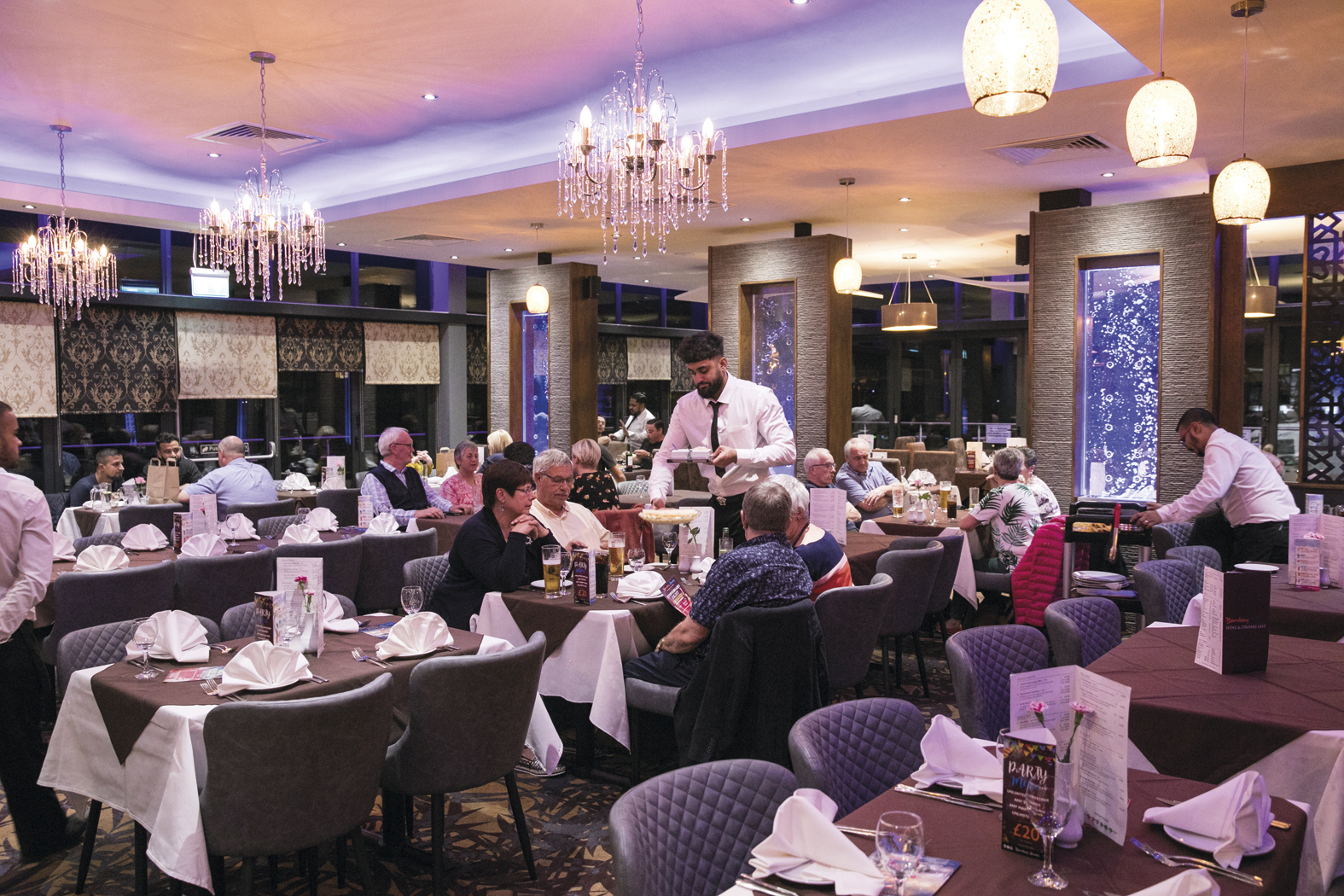
The End of Traditional Restaurant Service?
By Helen Salter
For many restaurant-goers, good service is one of — if not the — main draw for going out to eat. Old-school, interactive experiences between waiter and customer are just one way a restaurant can bolster its reputation, with restaurateurs taking pride in maintaining a service which can lead to regional and national recognition. However, in the face of the pandemic, the restaurant industry has had no choice but to implement many operational changes, altering the general state of dining, which we know and love.
One of the most prominent changes restaurants have seen this year is the shift from face-to-face service to QR codes and app ordering systems. Restaurant technology of this sort has been around for many years —the most obvious partaker being pub juggernaut Wetherspoons —though it’s been this year which has understandably seen a huge uptake in mobile ordering and paying systems: Wi5, a web-based mobile order & pay solution for hospitality, reported a 500% increase in sign-ups, with a 2000% per cent increase in customer-generated revenue.
Nevertheless, with the influx of QR codes and app ordering systems — not to mention safety measures such as mandatory face masks and visors for staff — the very ground of what constitutes restaurant service starts to shake. So, how are restaurateurs and diners responding to this shift in dining – does the current emphasis on tech offer a multitude of benefits, or, does it erode relationships between staff and customer, indicating a potentially devastating impact on a sector already struggling to stay afloat?
A positive shift for restaurants
“It’s a positive shift as long as it allows restaurants who want to stay open to stay open and encourages customers who want to eat out to eat out, and do it safely,” says London-based food and drink writer Lucas Oakeley. Indeed, implementing mobile technology can offer a business a number of advantages, such as monitoring customer demand, track and trace functionality, increase in safety and hygiene and giving the customer greater control. In a research study of 1000 diners by digital ordering platform Ordamo, technology solutions such as contactless payment came third in customer’s list of priorities, with 67% of respondents feeling it was safer to order from their phone rather than restaurant staff.
But do these safety advantages outweigh the social cost of losing face-to-face interaction? Mr Mashukur Rahman, who runs Indian restaurant Jhaal in Colchester, still provides a service to his elderly customers: “We provide them with the takeaway menu, because some have said they don’t own a smartphone. I like talking to customers face-to-face – I’m a local guy and 95% of our customers are regular. So, we like having a chat with them. It is a bit different now – people are trying to eat and go home rather than interrupting, so it has changed.”
“We do however have QR codes for the younger generation – it’s so easy for them to scan and take an order,” says Mashukur. “But if you go to my different level of customer – who will come here with their wife, perhaps 50 years old, will want to talk to the owners face-to-face – and this is where the problem is. So, we’re accommodating to both.”
While the central point of newly implemented tech is to help staff avoid close contact with customers — as well as preventing crowds and physical queues from gathering — it’s apparent there is resistance to its role, not only from staff but from diners, too. “I think I’m always going to prefer looking at physical menus and interacting with a real person rather than a phone screen because that’s part of the appeal of going to a restaurant for me,” says Lucas. “It’s being somewhere I can escape from the many, many screens in my life.” For lots of restaurant-goers, entering an establishment is a phone-free haven, a momentary slice of respite where phones are off the table and real-life conversations flourish. Those hoping for a tech-free evening are easily disgruntled, then, by the barriers presented with yet another app download, (provided they own a smartphone), potentially resulting in a dampened dining experience.
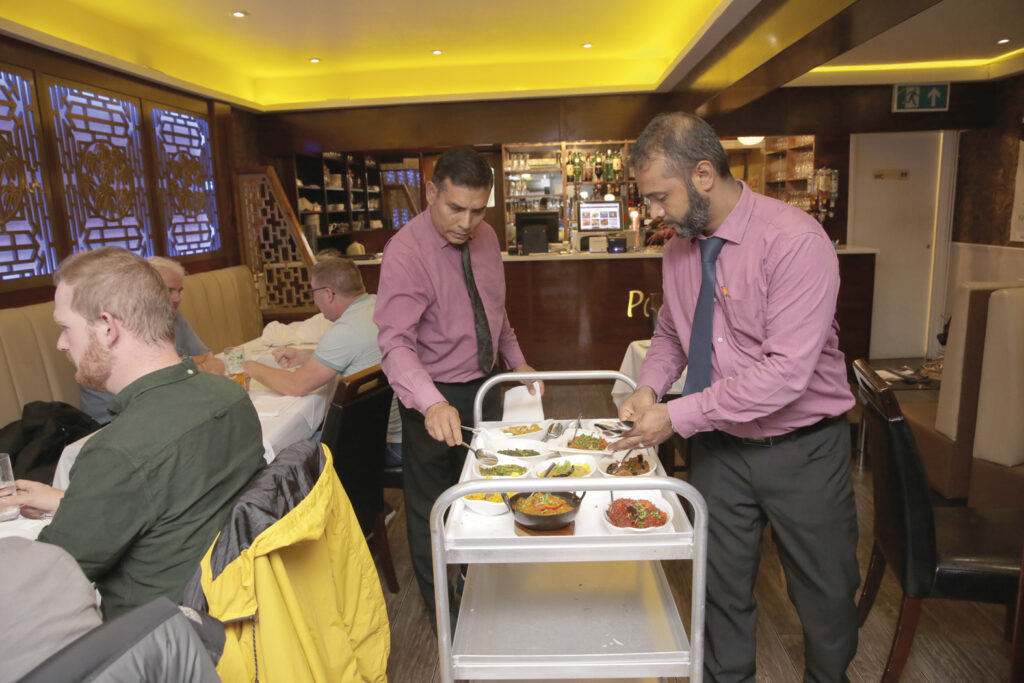
“Unpractical and too complicated to be used effectively”
“Face-to-face service is crucial for judging guest experience and making all visitors feel welcome – there are so many small details that are only conveyed by direct interaction between waiter and guest,” says the manager of one Soho restaurant, where waiters continue to serve customers. “It allows waiters to set the pace of an evening, and guides diners through any questions they might have. It’s a crucial feature of restaurant service: for the waiting staff to be present, and helpful, but not over-bearing,” the manager says.
“On the whole, the influx of technology in restaurants is a positive change, however in some cases it can become unpractical and too complicated to be used effectively. It’s also increasingly important for all team members to be confident with new tech and systems, which can alienate some workers,” the manager says. “I think the uptake in technology involved in hospitality venues will certainly change what we consider ‘traditional’ restaurant service but can never replace it. The importance of waiters in restaurant settings won’t be overlooked.”
It may be argued, crucially, that there is a time and place for a tech-driven dining experience: “If I’m looking for a quick lunch then I’m totally OK with the QR codes and apps – McDonald’s had already got that sort of ordering nailed pre-Covid and there are definitely benefits to it,” says Lucas. “Plus, if staff aren’t comfortable coming to tables and taking orders, then I’d rather they’re not forced to do that just for my sake!”
Data protection and breaches
Though many tech solutions such as Wi5 require no app downloads or registration, allowing a more frictionless experience, they do present numerous data protection challenges. Before re-opening on July 4th, the government asked all restaurants to collect personal data to assist in track and trace, allowing businesses to store potentially sensitive data. This means commercial exploitation, state databases and data breaches are all at play, posing greater privacy risks for customers.
Ultimately, when it comes to health and safety, reducing physical contact in the casual dining arena remains key to staying in line with government guidelines. Diner reassurance at a time when anxiety levels are high is paramount, not to mention the economic challenges many of us face in tandem. Most customer-facing technology — digital menus, contact-free orders and payment solutions — are specifically designed to shorten the time it takes for customers to receive and pay for the bill. Indeed, reducing time spent indoors is preferable in this climate and may, in turn, enhance customer confidence; Prask Sutton, chief executive and founder of Wi5, claims there’s evidence showing businesses could save around 17 minutes per order.
This smartphone-driven environment fails to consider, however, how unpredictable phones act when we need them most, owing to a shaky Internet connection, low storage and a low battery on the brink. “I’ve had a few issues; I don’t have data on my phone, so I rely on Wi-Fi whenever I’m out and about. Frantically attempting to connect to the Internet while scanning a QR code as a line of disgruntled people forms behind you can be a bit of a pain sometimes,” says Lucas. “But that discomfort is only momentary, and I wouldn’t say it detracts from the overall experience.”
Naturally, business owners ought to be eager to fully embrace technology should it bolster a beleaguered sector; any implementable measures which increase sales at a time when profit margin are slim and maintenance costs are rising are welcome. But how easy are they to implement, and is it cost-effective? Reports claim tech can cost up to £1000 to set up, with the cost of processing payments more than double what it is with your standard credit card provider. If you add these costs to the stress of operating at reduced capacity, and it’s clear to see the strain restaurants are under.

What is the future of restaurant service?
First-class service lies in the spirit of hospitality, and for many shapes not only a restaurant’s reputation but also the reason why so many want to work in the industry. So, what does the future look like for the sector? “This is the way we of doing business now. I believe it’s the new trend, we’ve said goodbyes to menus,” says Mashukur. “My future plan is every table will have an iPad, and from that you can order your food and pay as well. The only thing we’ll provide is the food and that’s how it’s going to be.
“I’m happy as an owner, because some of the staff, not matter how good they are, they make mistakes. The kids are different – they’re here to eat their food and go – they’re not interested in hearing your life stories, so for them it’s the way forward. It’s a generational argument and it’s going to go that way I think.”
“In business, if you want to go forward you have to keep up with the trends, otherwise you’ll be out of the market,” says Mashukur.
“I like talking to my elderly customers, they know me by name, and I know them by name, most of them don’t need the menu because I know the order, but the younger generation, they love using tech. I use a smartphone I don’t deny that, however when I go to a restaurant, I want to see the menu, but it’s not going to be there anymore.”
Though technology offers a safer, cleaner alternative to sharing menus and social interaction, the foundations of the restaurant experience go under threat. Will this new-found appetite for mobile tech last longer than the pandemic, and is the digital shift a sustainable one? “I hate to be a pessimist but whether or not it’s a viable long-term solution depends on what restaurants are still left after all ‘this’ is over,” says Lucas. “I’d be lying if I said the prospect of a world filled with restaurants that resemble McDonald’s and Wetherspoons wasn’t utterly depressing.”
With countless independents unable to introduce all of these digital measures, as well as the hundreds of owners smacked with further restrictions and the reality of a second national lockdown, the already ailing sector faces a perilous winter ahead – with jobs hanging in the balance.
Whether the future of restaurants resembles a technology-driven one, free of the old-school service between staff and customer, is not entirely up to restaurant-goers and owners, says Lucas: “I worry that by making these restrictions necessary, we’ll be phasing out a great deal of businesses and forcing them out of a dining landscape that they’re integral to. The government needs to work harder to protect those people and their businesses. Because restaurants might well survive but I’m not sure if they’ll be the sort of restaurants I’ll actually want to go to.”
Read more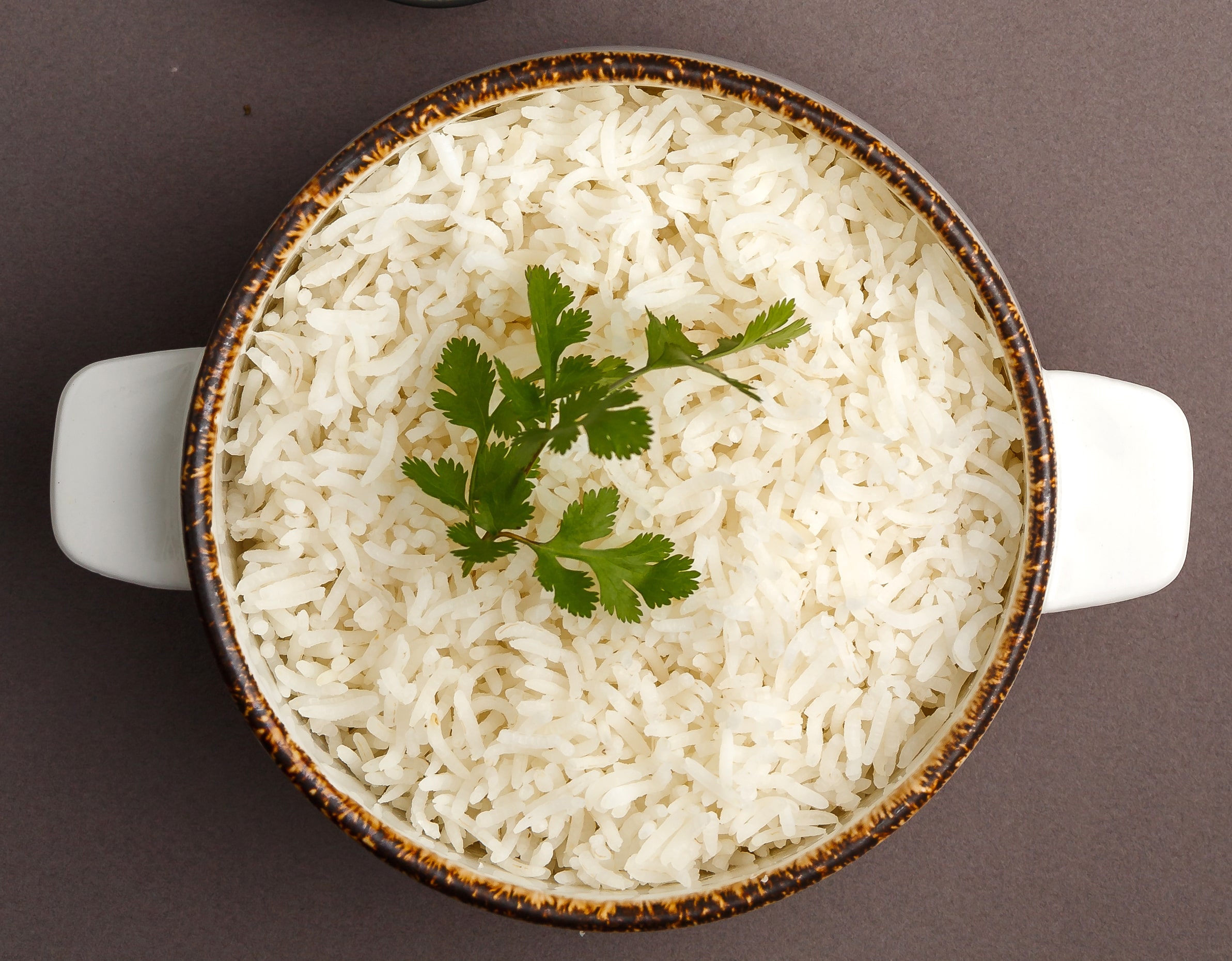
Basmati Rice Dispute Between Pakistan and India
Wherever you go in the world where curry is served, rice tends to follow. The two foods go together perfectly and have done for centuries. But now a dispute between India and Pakistan has arisen, with Basmati rice at its centre.
India enjoys a fruitful trade deal with the nations that comprise the European Union. They have applied to the organisation’s executive Parliament for Basmati rice to be recognised by the EU as a food that’s grown exclusively in regions of the Indian subcontinent.
As valued trading partners, the EU allows India and Pakistani to trade Basmati rice with them without the need for tariffs and additional charges. Something that benefits both nations and the EU themselves.
It also means that, as far as the EU is concerned, only rice from either of these two countries can ever be considered authentic Basmati rice. It is providing both India and Pakistan preferential treatment and a degree of exclusivity. This makes rice from both nations highly sought after and more valuable than rice from elsewhere.
However, India has now applied to the EU for full recognition of Basmati rice. They are arguing that two-thirds of the rice imported into Europe originates in India, not Pakistan. They believe that the deal between themselves and the EU should reflect this, meaning Pakistan risk being cut out of a lucrative trade agreement which they’ve enjoyed with the EU since 2006.
While India’s argument certainly carries some merit, and that it’s understandable that the country would want the best possible deal with the EU, it’s natural for Pakistan to object. While they may not export as much rice as India, they still supply a third of Europe’s rice.
Pakistan will not want to pay additional tariffs on rice trade when they’ve not needed to for fourteen years. Therefore, the Pakistani government has “vehemently” opposes the application by India to the EU.
India’s application to the EU now classifies rice by the following description, “The special characteristic of basmati is grown and produced in all districts of the state of Punjab, Haryana, Delhi, Himachal Pradesh, Uttarakhand, as well as in specific districts of western Uttar Pradesh and Jammu and Kashmir.”
Pakistan has countered that should the EU agree to these new terms, this would be a “hammer blow to Pakistani exporters” and risks damaging their business irreparably. Frictionless, tariff-free trading is one of the main benefits of EU trade.
Something that, if lost, can cause significant financial harm to a country’s trading prospects. This is why so many are opposed to the UK leaving the EU without a deal. Fresh tariffs could be applied to most items, crippling the cost of trade for those outside the EU marketplace.
Pakistan has launched a formal objection to the EU to prevent losing exclusivity and trading perks that come with Basmati rice. They will also raise the fact that the volume of rice that Pakistan supplies the EU has nearly tripled in the past few years. So, despite it still being less than India’s supply, it’s still of vital importance to both parties’ economy.
Commenting on the dispute, an EU spokesperson said, “The commission has published the application for registration of the name ‘basmati’ from India as a proposed protected geographical indication. This publication gives the opportunity for stakeholders to lodge oppositions for a three-month period.
“This publication does not imply the registration of ‘basmati’ but is a step in the standard geographical indication registration procedure. The final decision on registration is only taken after the opposition phase has been completed. This allows the rights of all parties to be respected in the registration process.
“If an opposition is received from any party, the commission will ensure it is examined in line withstanding procedures, ensuring the rights of all parties are scrupulously respected.”
The dispute is ongoing.

Mixed reactions over Eat Out to Help Out
Eat Out to Help Out, the latest government scheme aimed to help boost the hospitality sector and encourage diners to get back out, saw up to 83,068 restaurants sign up across the UK.
Created by chanceller Rishi Sunak, the scheme, which lasted all of August, meant businesses could claim up to £10 per person back on all food and non-alcoholic drinks served on Mondays, Tuesdays and Wednesdays. Diners were entitled to a 50% discount on food or soft drinks in any restaurant, pub or bar registered with the scheme.
Some restaurateurs are even calling on the government to extend the scheme beyond August; Khalis Miah, who runs Riksha Streetside Indian Restaurant in Aberdeen, launched a petition for restaurants affected by local lockdowns who missed out on the scheme.
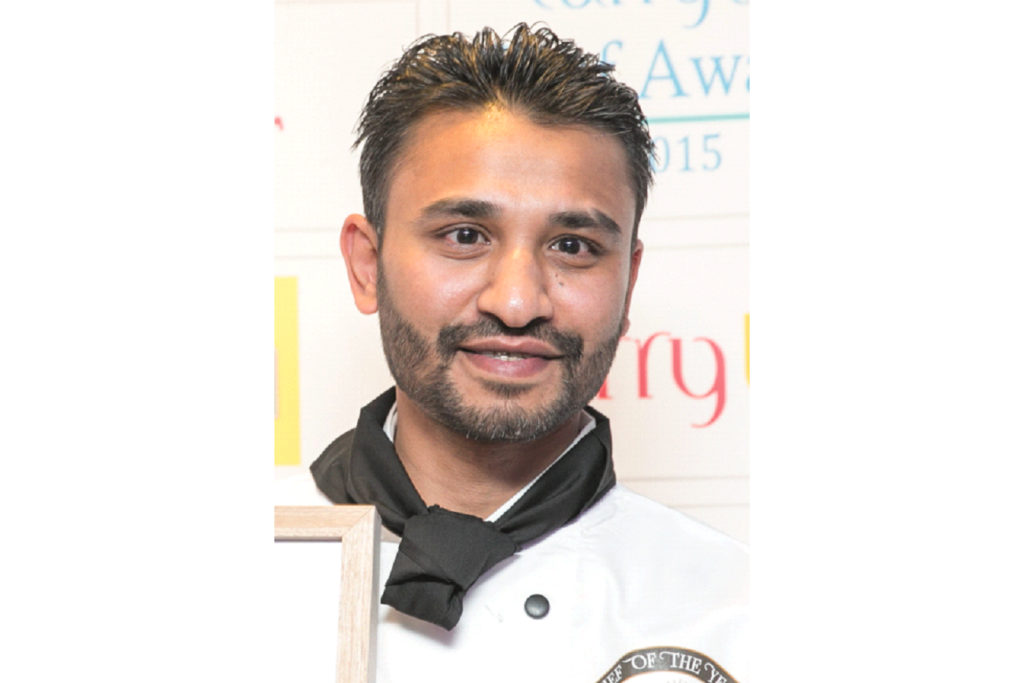
The government set aside £500m to fund the policy, with restaurants able to claim back the money within 3-5 business days.

pandemic has hit the hospitality sector the worst compared to any other sector; government figures show 80% of hospitality firms stopped trading in April with 1.4 million workers furloughed.
Aiming to provide the hospitality sector a much-needed boost in sales after the devastating financial impact of lockdown, Eat Out to Help Out oversaw impressive figures, indicating the UK’s appetite for half price offers: according to the chanceller, more than 35m meals were claimed in the first two weeks alone.
For many restaurants, the scheme has been overwhelmingly positive for getting business back on its feet. Abu Mojid, owner of Chandini Restaurant in Sawbridgeworth, says the restaurant has been “phenomenally busy” over the four weeks: “It’s been so busy that we’ve actually had to turn away customers,” he said.
For Mojid, the scheme has incentivized existing customers, who missed the buzz of a restaurant, along with plenty of new faces: “A lot of the clientele are new customers, which is a good thing from my perspective. Our prices are on the higher end, so I think that because of the discount, people are benefiting more from the higher end places.”
“The scheme has been a great marketing tool; we’ve been pushing it out a lot on our social media and that’s helped us massively.”

But what will happen for businesses after August? Nahid Khan, of Radhuni Resturant in Edinburgh, is cautious as to what the future holds as social distancing measures become the norm: “A lot of us have lost half of our tables due to social distancing, which I totally respect because we need to be safe and do our part to come out of this, but at the same time do we seek more government backing? Stick it out, reinvest in the equipment to help us operate while maintaining social distancing, or pull out? The scheme is a temporary fix for cash flow purposes, but how accurately can I tell you now about the future? A year ago, I could tell you a prediction for the next two years, but that’s changed now and that’s the biggest worry.”

Khan also claims the scheme has been logistically tough: “It has detracted customers from dining on the weekends; that’s usually the busiest time for us, so we’ve struggled to get enough staff to cover the start of the week, plus we didn’t want to hire staff just for a month.”
“There’s also been a lot of no shows – it’s very easy to book, but people don’t think it’s as easy to cancel, or they simply don’t care enough.”
Thanvir A Choudhury, owner of Viraj Indian Cuisine in Cornwall, would prefer to see the scheme later in the year when restaurants will need it most: “During the summer holidays, tourists are going to come out to eat anyway. We are only operating five tables, so customers will fill up the tables egardless of the scheme. For us, it would be more beneficial if it carries on throughout the winter; we won’t be seeing any big Christmas parties this year, so we’ll need the support of the scheme to keep our heads above water.”
Though the future of the hospitality industry is unclear, Khan remains largely optimistic: “The hope is that new customers return once the scheme is over, not just because of the discount. The main thing is that we’re all supporting one another; we all want to be able get out of this and get economy back up and running.”
In nthe meantime many restaurants in Britain are opting out of the Eat Out to Help Out half-price scheme because they are struggling to cope with demand and the attitude of customers according to a report in the daily Mirror. Simon Hulstone, the award-winning chef owner of The Elephant, which overlooks Torquay harbour, said the scheme has seen hungry punters getting very angry. Writing on Twitter, he said: “So much hate for being full on Tues/Wed from people.Even threatening to never eat with us again unless they can get £10 off other days !!! Very bizarre behaviour.

HOME IS WHERE THE BHAJI IS !
Ask people to name the most popular home-cooked meal in Britain – and which food comes to their lips?
Roast beef and Yorkshire pudding must surely be up there, you’d think.
Or perhaps good old favourites like fish and chips or even spag bol?
Well you’d all be wrong.
Unveiled as the country’s favourite national dish in a recent survey was….wait for it….curry!

The research – by supermarket app Ubermarket – found that over a fifth of 2000 respondents (some 21.6%) cited curry as their favourite food to cook at home.
Perhaps equally surprisingly, it was spag bol, which came a close second with the classic roast lunch struggling to get to third place.
Making up the numbers were two other dishes from foreign shores – in the shape of lasagne and chilli.
Drilling a bit deeper into the curry findings, it was Thai green curry which found favour with most people, with its simple-to-make mix of spices and coconut milk – followed closely by Indian classics like tikka, masala, biryani, korma and madras.
So what has caused this spread in popularity which has seen curry grow from being Britain’s favourite takeaway to now being the favourite food cooked in people’s homes?
There’s no doubt it all stems partly from the increased availability of more exotic, fresh ingredients than your common British spud – but there are other key reasons according to Habiba Chowdhury, who runs a successful, and growing, Indian cookery school and one-to-one classes from Northwich, Cheshire, called My Curry Club.
She explains: “I believe that palates in this country are more open than ever to new and exciting flavours – while at the same time people are getting more conscious of what they eat.
“This means that people are fussier about what they are cooking at home – and the wider availability of fresh ingredients in our supermarkets means they can have what they want.”
She adds: “Given the runaway popularity of Indian restaurant and take-away dishes, I suppose it’s not surprising that what people want in their own kitchens is curry.”
Another take on the growing all-round popularity of curry dishes comes from award-winning cookery writer, Mridula Baljekar.
The best-selling author of almost 30 Indian cookery books, who also runs cookery classes, says: “I think the main reason behind the spicy food epidemic in Britain is that people are travelling more to India and South East Asia. What they eat during their holiday, they want to replicate when they get back home.
“The other reason, of course, is that there is a large number of upmarket Indian and South East Asian restaurants in Britain today. These restaurants offer food that is very close to what people taste when on holiday.
“Home cooking is on the increase which is wonderful to see.” And who is behind this explosion in her view?
She adds “I find it quite amazing how a few Bangladeshis, who came to Britain with their British employers when the Raj ended, launched Indian cuisine in London first and then it’s continuous and extraordinary growth spread the length and breadth of the country. “This has made it what is now – nothing short of a phenomenon. We have the Bangladeshi community to thank for putting Indian food on the map in Britain.”
The growing willingness of Britons to experiment was also something picked up by the survey – with 22% of home cooks exploring recipes on social media or in books before turning theory into tasty reality – while 21% said the recipes they tried out were completely new to them.
So what tips can our experts, Habiba and Mridula, pass on to aspiring home chefs?
Habiba believes that good planning is the secret to using scarce time ‘so that people can multi-task and make more than one dish at a time’ – while Mridula advises cooks against over spicing dishes ‘so that the natural flavours of the meat, poultry, fish and vegetables shine through.”
The ease of making a good curry – compared with the relative complexity of preparing a roast – is another reaction to the Ubermarket study, with one home-cooking fan speaking for others when saying ‘with all the increasing pressures on people’s lives, there’s something very attractive and satisfying about putting together a quick-fix curry.”
Whatever the reason, the survey is further evidence that the dish is continuing to curry favour with increasing numbers of British families.
Read more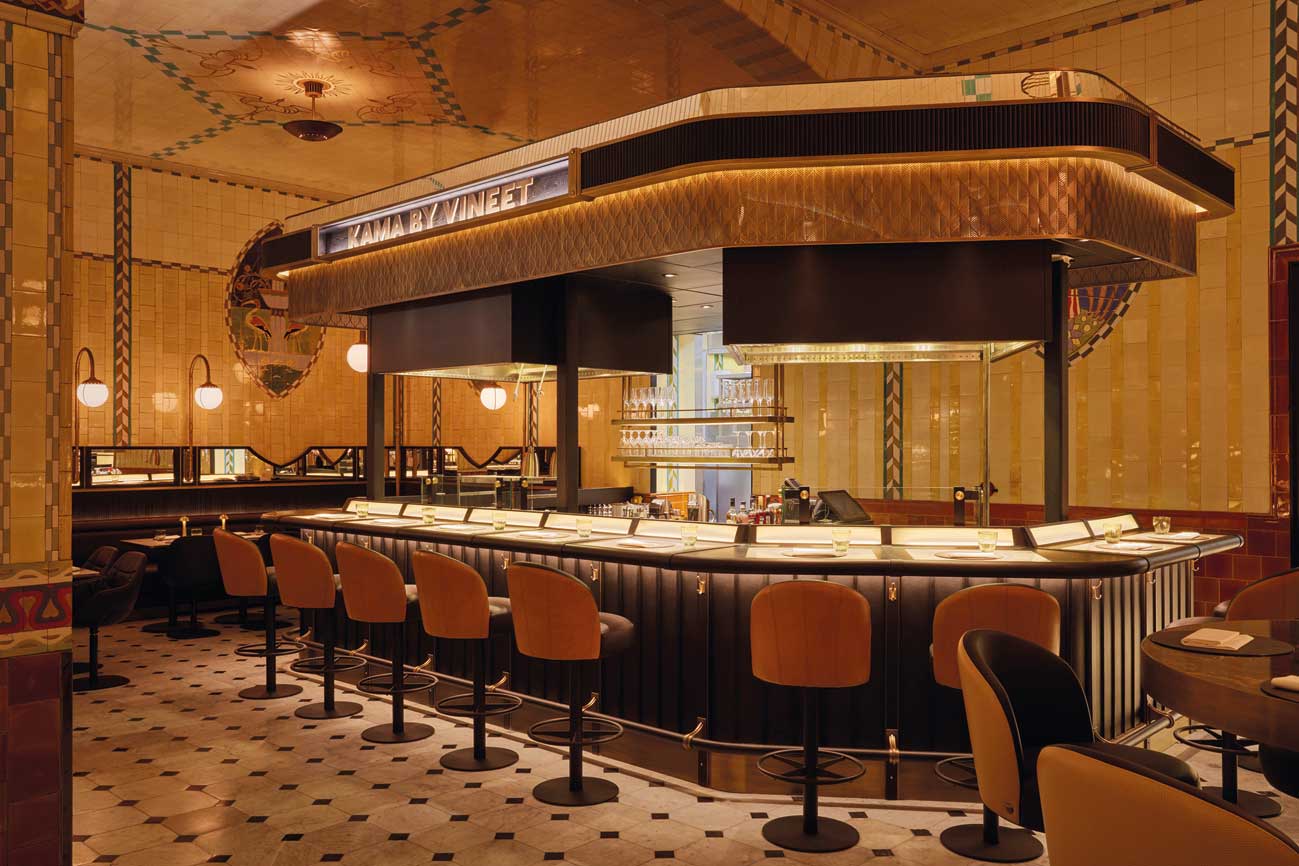
Harrods Welcomes ‘KAMA by Vineet’ at the new Dining Hall
Harrods’ new Dining Hall marks the third phase of the monumental restoration of the store’s iconic Food Halls. Formerly known as the Meat & Fish Hall, the new Dining Hall is designed to be an elevated experience, giving customers the chance to sit and enjoy produce sourced directly from the Roastery & Bake Hall and the Fresh Market Hall, prepared by Harrods’ own chefs.
The new room is set to become a must-visit culinary destination in Knightsbridge, where locals, London foodies and Harrods shoppers alike can enjoy fresh and seasonal dishes made with specialist ingredients and the finest fish and meat, alongside handmade pasta.
Trusted partners such as Kama by Vineet and Caviar House & Prunier are part of the line-up; The Sushi Bar is headed up by Eddie Lim of the Mango Tree group; while The Wine Bar, in the heart of the room, offers an international wine list curated by Harrods’ expert team of buyers.
Bringing authenticity back to London’s Indian food, world-renowned Michelin star chef Vineet Bhatia has curated a menu of modernised regional dishes from all over India for this Dining Hall restaurant.
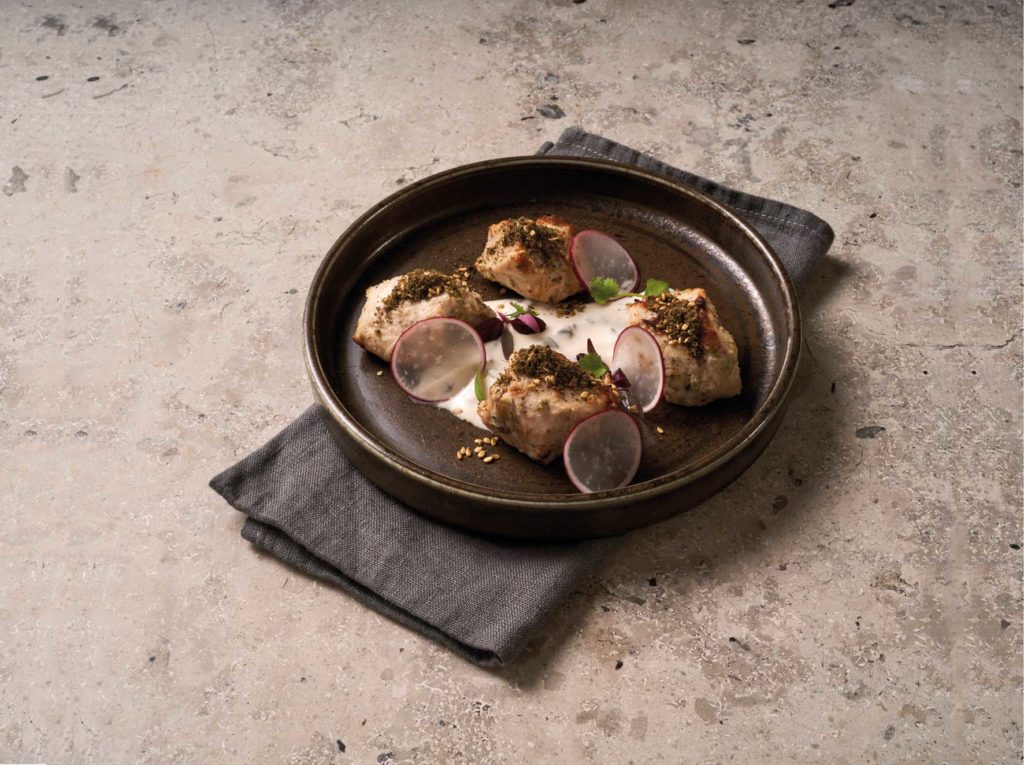
Andy Cook, Executive Chef at Harrods, says of the new room: ‘The new Dining Hall is a dynamic, live experience celebrating the exceptional level of talent and service our team of 150-in house chefs and servers deliver daily to our discerning customers. Each menu offers a modern, seasonal and relevant take on traditional dishes as well new and bespoke house cocktails, all made in-house with the finest ingredients in the world.”
At The Fish Bar, the menu champions the best of British fish and seafood from the Fresh Market Hall, ethically caught and directly sourced by Harrods fish buyers and fishmongers. Key dishes include signature Harrods fish and chips, ceviche, a catch of the day, and smoked salmon from the Faroe Islands, all beautifully served.
The Grill showcases the finest meats, ranging from dry-aged beef, Wagyu and rotisserie chicken (from Packington Farm) to seasonal game. The Harrods chefs have created a simple but classic menu; this includes T-bone, fillet and porterhouse steaks, all cooked to order over a charcoal grill and served alongside a selection of sides including Truffle Mac & Cheese, triple-cooked fries and creamed green vegetables.
Specialising in seasonal takes on traditional Italian recipes, The Pasta Bar will be the go-to destination for fresh handmade pasta. The menu will change daily based on the seasonal produce delivered each morning, complemented by staple hero dishes including Pappardelle al Ragù and Focaccia di Recco.
Centre stage in the new Dining Hall is The Wine Bar, where guests can choose from a menu of more than 100 wines by the glass. The menu has been curated by style, not by terroir to allow guests to explore wines within a flavour profile that they are familiar with. Using the Coravin preservation system for still wines and the Genii preservation system for sparkling, exclusive bottles are served by the glass and can be experienced in perfect condition for up to 12 months.
Vineet Bhatia’s 26-seat restaurant, Kama by Vineet, introduces Harrods customers to a newly created menu by the world-renowned chef, featuring modernised regional Indian classics such as thali, and a variety of curries.
Meanwhile, the Sushi Bar offers speciality nigiri with a selection of sauces including truffle yuzu and traditional soy, while an expansion of Eddie Lim’s Asian offering is also available at the new Bao Kitchen on the Fourth Floor, where customers can enjoy a selection of dim sum, bao buns and rice bowls.
Read more
COBRA BEER LAUNCHES MINI KING COBRA
Following the success of multi-award-winning King Cobra, the world’s first Pilsner style lager double fermented with an ale yeast, Cobra Beer is delighted to announce the on-trade launch of Mini King Cobra – the same unique expression of liquid, packaged in a smaller 375ml offering. The Mini King Cobra Launch precedes the imminent relaunch of the newly-branded 750ml King Cobra, following a £1.2million investment into the re-alignment of the brand as a world-leading beer brewed smooth to be the ideal accompaniment to a host of different cuisines.
Mini King Cobra’s first venture into the on-trade is a partnership with Kama by Vineet, located within the newly renovated Harrods Dining Hall. The restaurant, headed up by Vineet Bhatia, the first Indian chef-proprietor to receive a Michelin star, is the first Indian restaurant to feature in Harrods’ 170-year history. Mini King Cobra has been chosen by Vineet as the perfect premium pairing to the Lobster Chettinad Biryani.
Brewed in Belgium’s historic Rodenbach Brewery, Mini King Cobra is created using the finest barley, malt, hops from Bavaria’s Hallatau region, and crucially, rice, before undergoing the primary fermentation process. The liquid is subsequently refermented in the bottle – precisely the same method to that of champagne – to produce a premium, warming and powerful depth of malt flavour coupled with an extra smooth yet frothy mouthfeel.
A versatile liquid that can easily pair with spicy food, fish and meat alike, Mini King Cobra is Brewed Smooth For All Food – the soft mouthfeel soothes whilst the sweet malt flavour enhances a wide array of flavours.
Vineet Bhatia comments: ‘The partnership between KAMA and Mini King Cobra could not be more perfect. The bottle itself is not only a work of art that looks right at home in Harrods’ Dining Hall, but the smooth, fruity taste with these unique, hidden depths serves only to enrich the flavours on our menu at KAMA.
Of course, the beer compliments many of the dishes, but we do encourage our guests to try the Mini King Cobra with the Lobster Chettinad Biryani. Together, the tropical, fruity taste of the Cobra lands upon the rich, warming flavours of the lobster, creating something quite magical. Our name, ‘Kama’, comes from the Sanskrit word for ‘desire’, and this is certainly a combination to desire.’
Lord Bilimoria, Founder of Cobra Beer comments: ‘I am thrilled to be launching our award-winning King Cobra in a smaller format. It is also an honour to be launching into the on-trade with a partner such as Vineet Bhatia – he represents truly refined and premium cuisine, and we are so glad that he views Mini King Cobra as the equivalent drink to pair with his exquisite Lobster Chettinad Biryani. All Cobra Beer is Brewed Smooth For All Food, and we are excited to launch this premium offering for consumers to enjoy with whichever cuisine they may choose.’

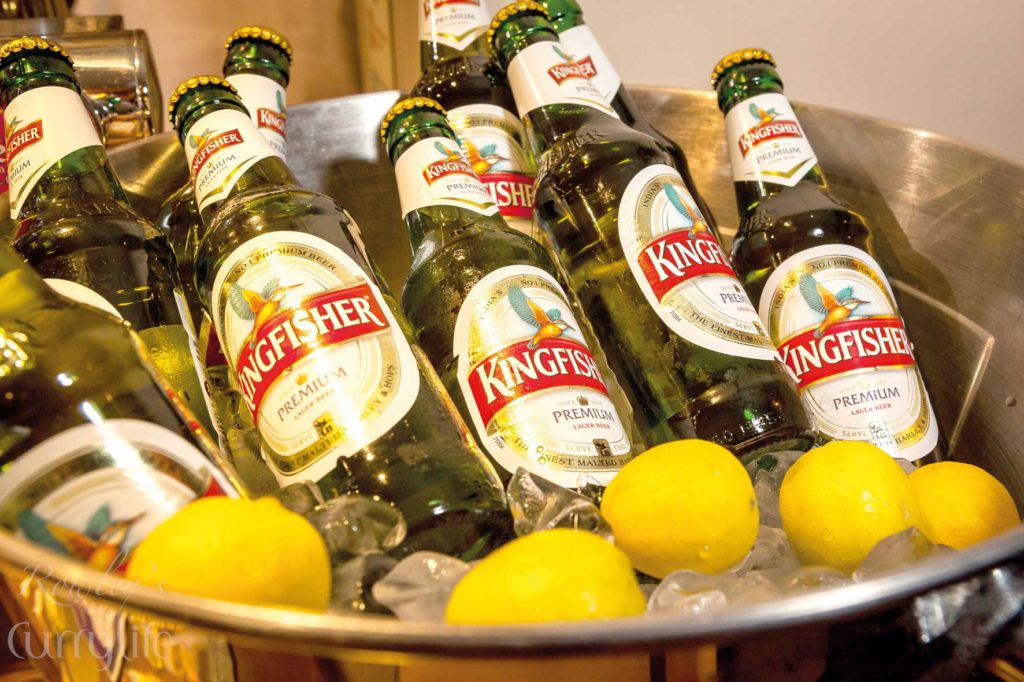
Kingfisher announces partnership with Southampton Football Club
The club is one of the Premier League’s longest serving and like Kingfisher, has a rich history of producing the finest.
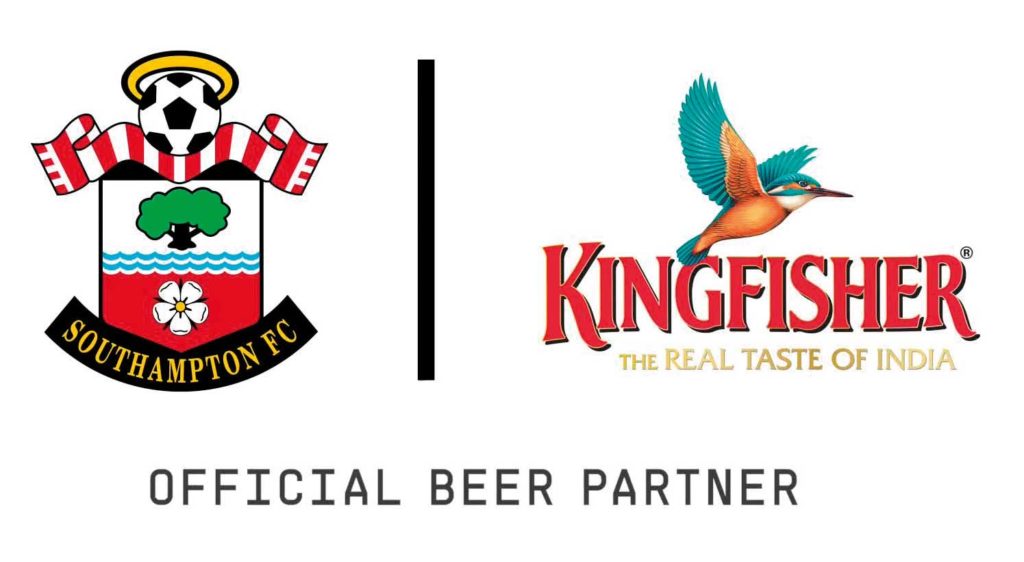
The agreement represents Kingfisher’s first ever partnership in the Premier League, as it looks to grow its presence around the world. As Official Beer Partner, Kingfisher will now provide the match day beer at St Mary’s Stadium for supporters, while it will also be launching a special Southampton FC signature ale, which will be available on draught at all home games. Also served at the ground and in hospitality will be a trio of other iconic World beers from Kingfisher’s UK product portfolio.
Kingfisher will also be working with the club to enhance the match day experience at St Mary’s for supporters, including bringing a unique Kingfisher flavour to the Fan Zone outside the stadium.
Through a number of exciting initiatives, Southampton and Kingfisher will, in addition, be taking the Premier League to India through a range of innovative content and a selection of unique experiences.
Southampton Football Club’s Commercial Director, David Thomas, said: “We are delighted to be welcoming Kingfisher into our valued family of commercial partners, and are looking forward to providing our supporters at St Mary’s with the offering of their range of high-quality, leading beers.
“Like ourselves, Kingfisher possesses a long, established history, while also priding itself on innovation and its ability to think differently, and these shared values mean we have a partnership that is built on incredibly strong foundations.
“Kingfisher is a world-renowned brand, and we are excited about being able to help them further grow their reputation both here and around the world, as well as working with them to provide a new gateway for the Southampton name in India.”
Shekhar Ramamurthy the Managing Director of Kingfisher’s parent company United Breweries comments “This is a hugely exciting partnership for the Kingfisher brand and we look forward to engaging with Southampton fans across the globe. India’s growing interest in the English Premier League is unquestionable and we are thrilled to be partnering with this dynamic club in the world’s best football league”.
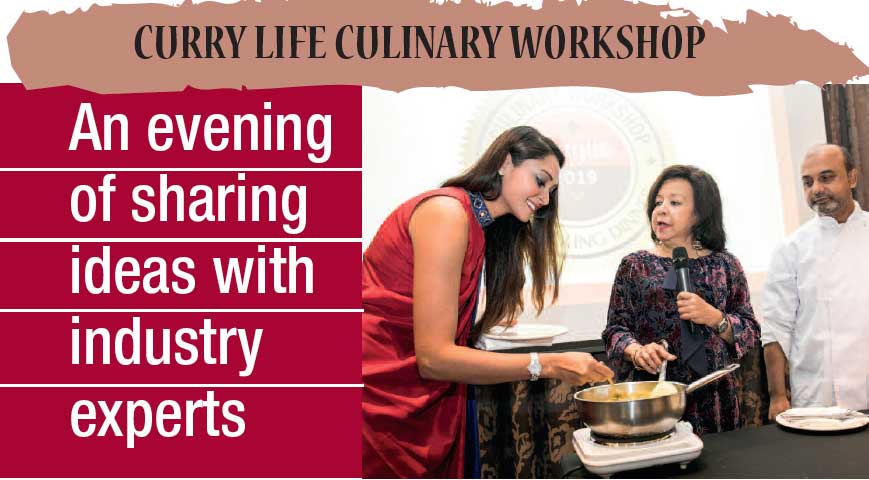
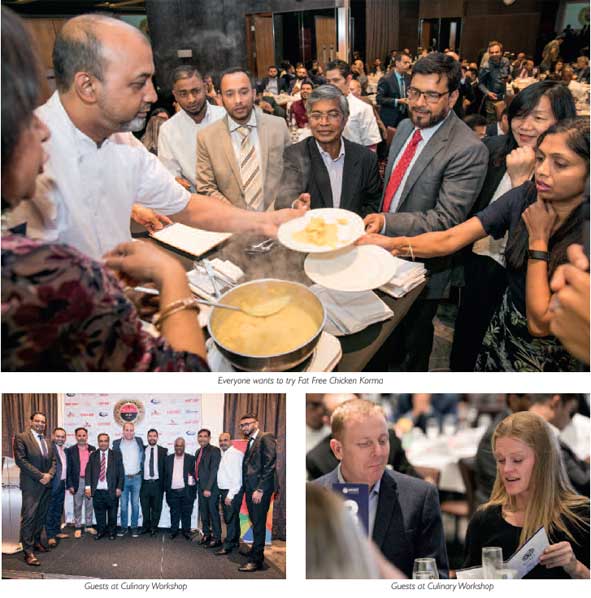
An evening of sharing ideas with industry experts
The main purpose of this event is to raise standards and learn new techniques,” says Curry Life Editor Syed Belal Ahmed. It’s the only way forward.”
Now in its eighth year, a stellar line-up of distinguished speakers journey to the Radisson Blu Edwardian hotel in East London on August 19th, along with 150 restaurateurs and chefs from establishments up and down the country.
After nibbling on a selection of tasty canapés and mingling with other attendees, we enter the main space – taking our seats, we settle in for the proceedings. First up, from global public health organisation NSF, and representing headline sponsor Just Eat, is Ashvini Pancholi-Dhillon.
“84% of people who eat out or order online are aware of food safety,”. They don’t want to dine at a place that has a zero, one or two rating”she says. To combat that, NSF provides a number of services – some free – such as improving hygiene and compliance.
Leading on from that perspective, Ben Palmer from drinks partner Kingfisher Europe addresses the audience. “We’re facing huge challenges,” he says. “We all recognize that there are turbulent times ahead because of workforce shortages and Brexit. A recent CGA report cited that Asian dining alone has gone down by 3% this year. That should sound alarm bells.”
Showing resilience is the best way to deal with such issues. “We’ve got to lead the way in innovation, stay ahead of the curve, and become more diverse and regional,” says Ben. “That will attract the new millennials of this world, who aren’t interested in – dare I say it – chicken tikka masala. They go to Pakistan and India and want to try what they ate there, back here.”
What else can be done to help the situation? Experimenting with new ingredients, such as jackfruit should be high on the agenda. With that, Noreen Finnamore from Buckley & Beale World Food is handed the mantle and extols the virtues of the natural, versatile option. Good for the planet, easy to grow, and nutritionally dense, it also offers a meat-like texture and has a remarkable ability to soak up flavours.
“A staggering 92% of plant-based meals consumed in the UK last year were eaten by non-vegans,” says Noreen. “This is not a fad; it has wide appeal.” In line with that, Buckley & Beale has been working with The Jackfruit Company to launch an ethical and sustainable product that’s imported from India and prepared especially for food service. Giving guests the opportunity to sample some, Chef Abul Monsur whips up a biryani, where spices and shreds of the savoury-tasting fruit mingle with rice.
Rupert Rowley takes to the stage next and says a few words. Having been at the helm of Michelin-starred Fischer’s Baslow Hill for seventeen years, he now holds the position of Development Chef at MSK Ingredients. “The easiest thing is to take something fantastic and do very little to it,” says Rupert. “That’s what it’s all about – the quality determines the end result.”
More and more, people want to know the provenance and history of what they’re eating. And they’re keen to hear what makes a dish stand out from other versions. “If you can answer those questions, you’re justifying what you’re doing and can charge more money,” says Rupert.
As he takes his seat, ‘Curry Queen’ and author of twenty-seven books Mridula Baljekar rises, and impresses with talk of fat-free Indian cooking. “You may think it’s impossible to do, but it’s not,” she says. A health scare prompted Mridula to re-think her diet and delve into a new way of creating recipes. “After a lot of trial and error I came up with a method by which you can make delicious food without a drop of oil, by using the natural fat that’s present.”
Mridula demonstrates by conjuring up her adaptation of chicken korma, using pre-roasted ground spices, low fat yoghurt and a single cream alternative. “That is absolutely delicious,” says a taster from the crowd, “I can’t tell the difference.”
With a handful of speakers left, we listen to esteemed veteran Mark Poynton advise on why healthy eating choices should be offered, Health Officer Shamsul Islam command the subject of allergy awareness, and Restaurant Manager Mo Gherras highlight the significance of polished and authoritative service.
And then it’s time to tuck into a Bengali feast prepared by established enterprise Mint Caterers. Starters of silken chicken reshmi kebab and textural aloo papri chaat are wolfed down, with empty platters soon replaced by steaming bowls of melt-in-the-mouth lamb shatkora bhuna and king prawn jalfrezi – the plump crustaceans are generously coated in fiery sauce and peel away from their shell with ease. Desi veg is flecked with jackfruit seeds – nut-like, they add a subtle crunch.
As the night draws to a close, Syed’s words ring in our ears. “It’s important to talk to each other;” he says. “If we don’t change, our industry will die out.”
Read more
Tesco Launches new Chilli Pepper
It’s known as The Armageddon and it’s so hot that it just about stands head to head with the notorious American-bred Carolina Reaper.
Since first going on sale at Tesco three years ago, the Carolina Reaper – which is officially the world’s hottest chilli according to the Guinness Book of Records – has become the stuff of legend because of its truly incredible heat.
But now the ‘Reaper’ has a rival that was not only bred in Britain but is commercially-grown in Bedfordshire.
And that should please the growing army of super-hot chilli pepper lovers in the UK with demand at Tesco for the top of the heat scale variety rocketing by 70 per cent in the last four years.
The Armageddon is being grown by the UK’s largest producer of chilli peppers, Salvatore Genovese whose seven acre farm is based in Blunham, Bedfordshire.
Salv, as he is known, started growing chilli peppers just under 20 years ago after he took over his parents’ cucumber business.
He branched out into chilli pepper production against his father’s advice but quickly found he had a fast-growing market with Tesco becoming one of his first customers.
Since then chilli peppers have become so popular that Salv now grows up to one million, or 15 tonnes, each week through his company Genovese Chillis, to satisfy the growing UK demand.

Sea Arch – The Non Alcoholic alternative gin
Inspired by the rugged coastline of Devon, Sea Arch: a sophisticated non-alcoholic gin-alternative has launched.
The premium spirit, blended and bottled in England, contains eleven carefully selected botanicals, twice-distilled in a traditional copper pot with spring water. The alcohol is then removed to leave behind pure, evocative flavour. This balanced sipper is best enjoyed on the rocks with a quality tonic and a slice of citrus.
Each sip offers juicy top notes of cardamom, blood orange and grapefruit, with a smooth long-lasting finish, drawing on samphire, cardamom and sea kelp, hand-harvested from the South Devon coast. Gin lovers will love the unmistakable base flavour of juniper. The launch is in line with the decline of alcohol consumption in the UK, which fell from 3.07 units per day in 2003, to 2.57 units per day in 2017.
Read more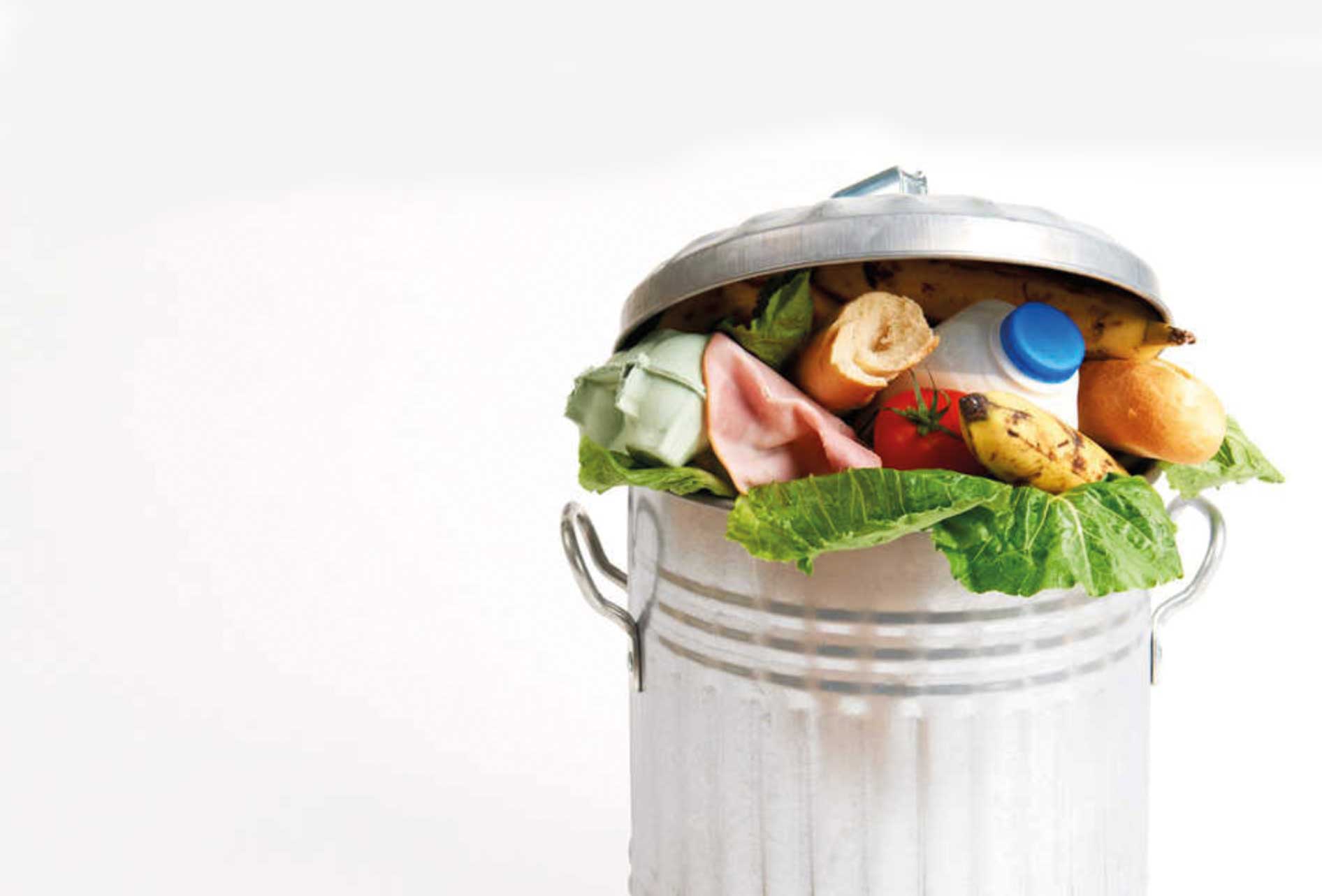
How to halve your food waste
In support of the Government’s initiative to halve food waste by 2030, major UK supermarkets and food companies have signed a pledge to tackle the problem. The companies have committed to “ground-breaking action” to drive down food waste and raise public awareness, the Department for Environment, Food and Rural Affairs (Defra) said.
Environment secretary Michael Gove said: “I am delighted to see so many UK food businesses commit to game-changing action to cut food waste, and I hope that others follow suit. The UK is showing real leadership in this area, but each year millions of tonnes of food is wasted. Together we will end the environmental and economic scandal that is food waste.”
The government’s food surplus and waste champion Ben Elliot said: “We are pleased to see these retailers committing to change. To those retailers yet to sign the pledge – why not? You have a responsibility to step up and do your bit. The food waste crisis can only be solved by collective action.”
An estimated 10.2 million tonnes of food and drink are wasted every year in the UK after leaving the farm gate, worth around £20 billion. Families blow £15billion a year — an average of £500 each — on food that is thrown away but could have been eaten.
Earlier this year the government launched a £15 million scheme to tackle food waste, building on its Resources and Waste Strategy which sets out how the government will introduce annual reporting of food surplus and waste by food businesses.
Here are five ways how you can cut down on food waste:
Storage and stock rotation
It is easy to get carried away and buy ingredients in bulk because you’re getting good deals, even when you’re not sure whether you’ll use everything. Even if there are bulk purchases, ensure that all stock is stored right, in clean and healthy packaging and food containers. Regarding food rotation, make sure older stock is used up before opening new ones.
Right temperatures
Maintaining accurate temperature control for various food items is crucial as it prevents spoilage and consequently reduces waste. This covers cooling hot food rapidly, heating cold food at right temperature, freezing and thawing meat and vegetables.
Have clear labelling
All food items should be marked and bear correct date and product information including mentions about allergens, suitability for vegetarians and non-vegetarians. It is essential to mention detailed use-by and end date of products when in storage and have a proper labelling system.
Watch the portions
Large food portions simply result in more food wastage. According to previous studies, chips and salads are often left behind, as it is considered to be an additional part of their main meal, which they didn’t ask for, hence don’t care to finish it.
Tie up with a local charity
Many restaurants have established connections with local charities that give away food. This helps is utilization of food as well as serving the poor and hungry.
Read more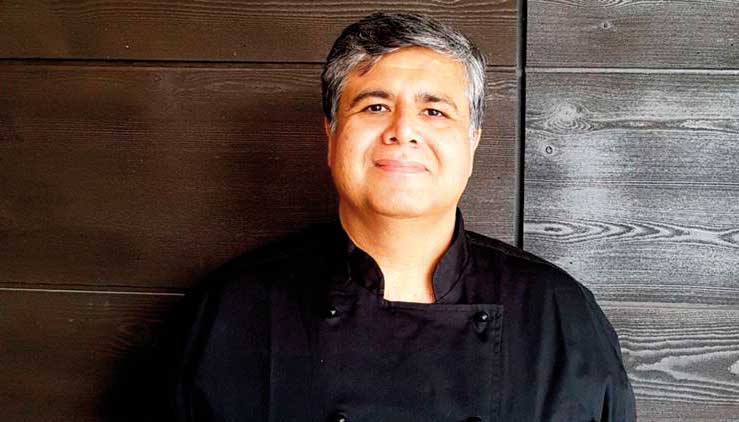
Restaurant chain rocked by ‘Knorr-gate’ scandal
Restaurant chain rocked by ‘Knorr-gate’ scandal
The executive chef of the Tamarind chain of Indian restaurants has been embroiled in a row over whether or not he used Knorr chicken cubes to flavour dishes.
Michelin chef Karunesh Khanna was alleged to have told a manager that ‘guests didn’t need to know’ and that the cubes had been used in vegetarian and vegan meals at the Tamarind Kitchen in Soho.
The claims emerged during a recent employment tribunal brought by manager Mafis Ali who lost his job after raising concerns with his bosses.
Tamarind director Fateh Dhaliwal backed his chef saying the accusations were simply that of a disgruntled former employee
A spokesperson said: “Mr Mafis Ali is seeming to use independent media resources to harm our business. Mr. Ali wrongly claims that we were misguiding customers about Halal dishes.
“We are not a Halal restaurant and have never been one. We have always served alcohol and continue to do so. Furthermore, we have never used chicken stock powder in Vegan or Vegetarian meals.”
The furore received widespread media coverage with some choice headlines including the Daily Mail’s ‘Laughing Stock!’
Mr Khanna admitted he used Knorr stock while working at Tamarind Kitchen in Soho while the flagship Tamarind Mayfair restaurant was undergoing refurbishment last year, according to the documents
The tribunal looking into the allegations found no clear evidence of chicken stock cubes being used in vegetarian and vegan dishes.
The tribunal said: “What is clear is that the claimant genuinely believed that Knorr chicken stock was being used both with halal meat and in vegetarian and vegan meals.
“The claimant was very concerned that customers maybe mislead by the addition of the chicken stock and was particularly concerned about the allergen charts being updated.”
However, the tribunal did rule that Mr Ali has been unfairly dismissed and awarded damages equivalent to one month’s wage .
There are three restaurants that comprise the Tamarind Collection group: Tamarind of Mayfair, Tamarind Kitchen in Soho, and Zaika in Kensington.
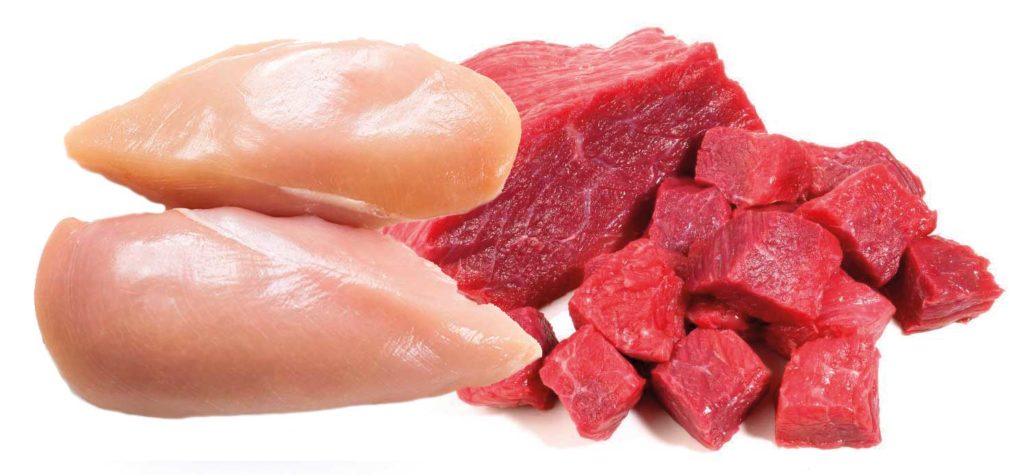
Study shows white meat just as bad as red meat
Eating white meat, such as poultry, will have the same effect on your cholesterol level as eating red meat, a new research has found. Though the common belief that white meat is less harmful for the heart, both red meat and white meat contain saturated fats, which increase levels of LDL (“bad”) cholesterol and increase a person’s risk of heart attacks, stroke and peripheral artery disease.
The study from the Children’s Hospital Oakland Research Institute (CHORI) found that people who ate white meat diets consisting of chicken and turkey ended up with cholesterol levels that were no different from those who ate red meat diets consisting of lean beef or pork. Both diets caused significant jumps in cholesterol compared to people whose diets consisted of plant-based proteins.
“When we planned this study, we expected red meat to have a more adverse effect on blood cholesterol levels than white meat, but we were surprised that this was not the case — their effects on cholesterol are identical when saturated fat levels are equivalent,” said study senior author Dr. Ronald Krauss, senior scientist and director of atherosclerosis research at CHORI, in the study’s press release.
The study involved a 113 healthy men and women between ages 21 and 65 were randomly assigned to either the high-saturated fat, provided primarily by butter and full-fat foods, or low saturated fat groups. All participants tried a red meat, white meat and plant-based protein diet for one month each, with the order in which they ate these diets decided at random.
In between the monthly diets, participants were able to eat their normal diet for a few weeks. Cholesterol levels were checked before and after each test diet. The main source of red meat provided by the researchers was beef, while chicken served as the main white meat protein. Blood samples were collected from all the participants at the start and finish of each test diet.
The study did not include fish, grass-fed beef or processed meats. The plant-based diets emphasized the consumption of legumes, nuts, grains and soy products. Both the red and white meat likely raised the participants’ cholesterol levels higher than the plant-based diet because they contain different kinds of fat.
The study authors said this is the first study to show that both kinds of meat — red and white — cause cholesterol levels to go higher than plant-based protein sources.
Read more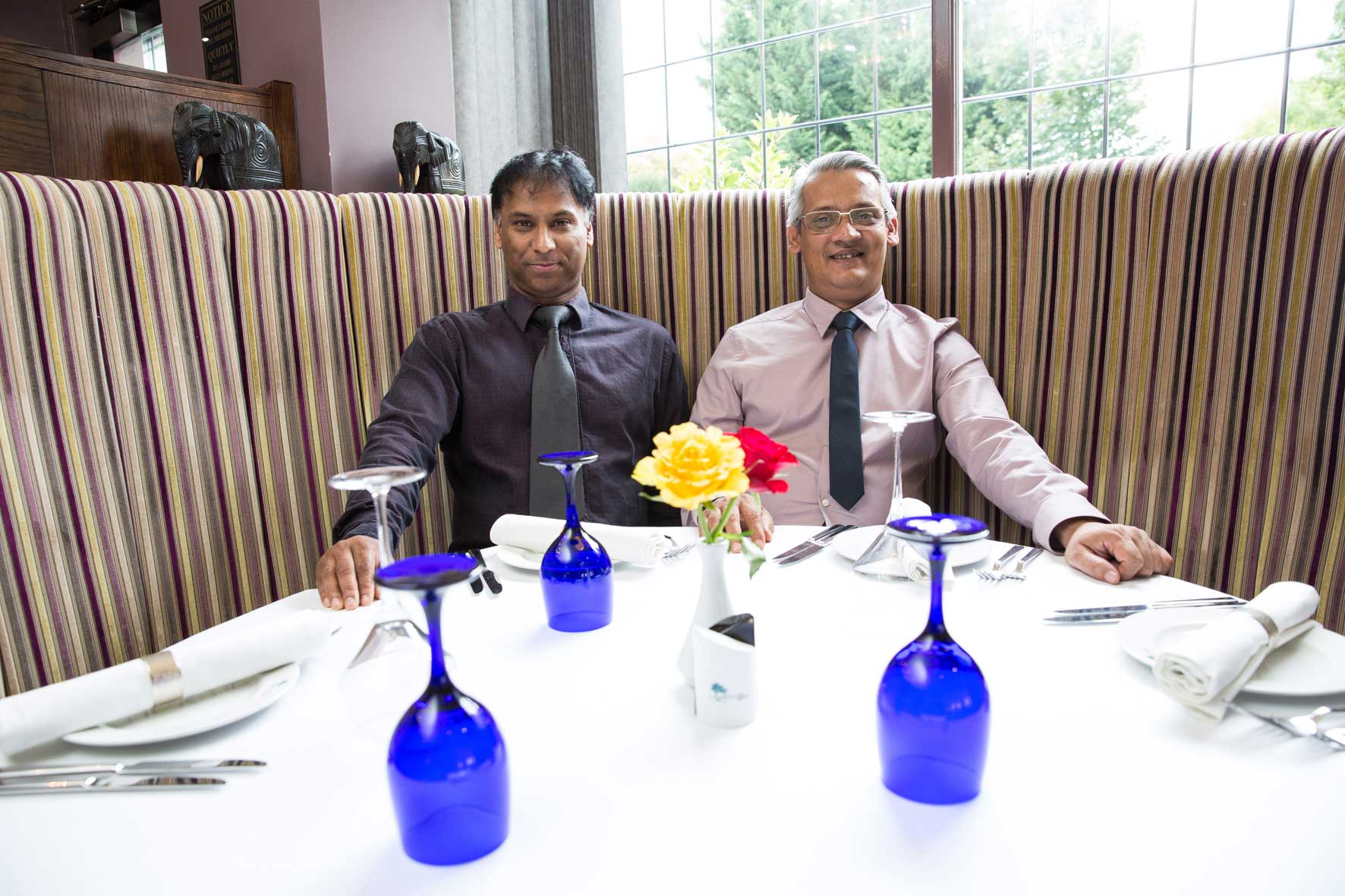
Dine BY THE RIVERSIDE
An old friend used to be fond of saying – ‘once you’ve been to one Indian restaurant, you’ve been to them all.’
He’d obviously never been to the Riverside Spice in the heart of the Essex countryside – which stands out both for a beautiful setting and its highly individualised approaches to traditional dishes.
Owner Abdul Hamid sums up the restaurant’s philosophy thus – “I’ve always said I wanted the restaurant’s food to have the same sort of attention to detail as home cooking and we have spent at lot of time and effort tweaking our menu to reflect this.
“The resulting recipes are handed down from chef to chef so that standards remain consistently high.”
Add this painstaking approach to the stunning, typically-English, surroundings of the village of Earls Colne, just outside Colchester, – and you have anything but your common-or-garden Indian restaurant – something that was confirmed when the restaurant won Best Essex Restaurant in last year’s National Curry Awards by Curry Life Magazine.

Putting these high standards to the test, we thought we’d ask Mr Hamid which dishes had a particular ‘Riverside flavour’ – and were treated to a fascinating tale of how recipes had been tried and tested over the years by various members of the family.
We started with one traditional House Mixed Platter and something slightly different, in the shape of a Chicken Momo.
The latter comprised shredded chicken in a fried bread wrap which scored heavily for its delicate blend of mixed spices and onions topped off with a tasty tamarind sauce.
Even the mixed platter – comprising chicken and lamb tikka plus Tandoori chicken and spicy kebab – benefitted from subtle tweaks in spicing which made it better than your average platter plate.
Starting to fill slightly full already, we nonetheless pressed on stoically to sample a set of mains that also clearly benefitted from the owner’s attention to detail – and twists on traditional dishes.
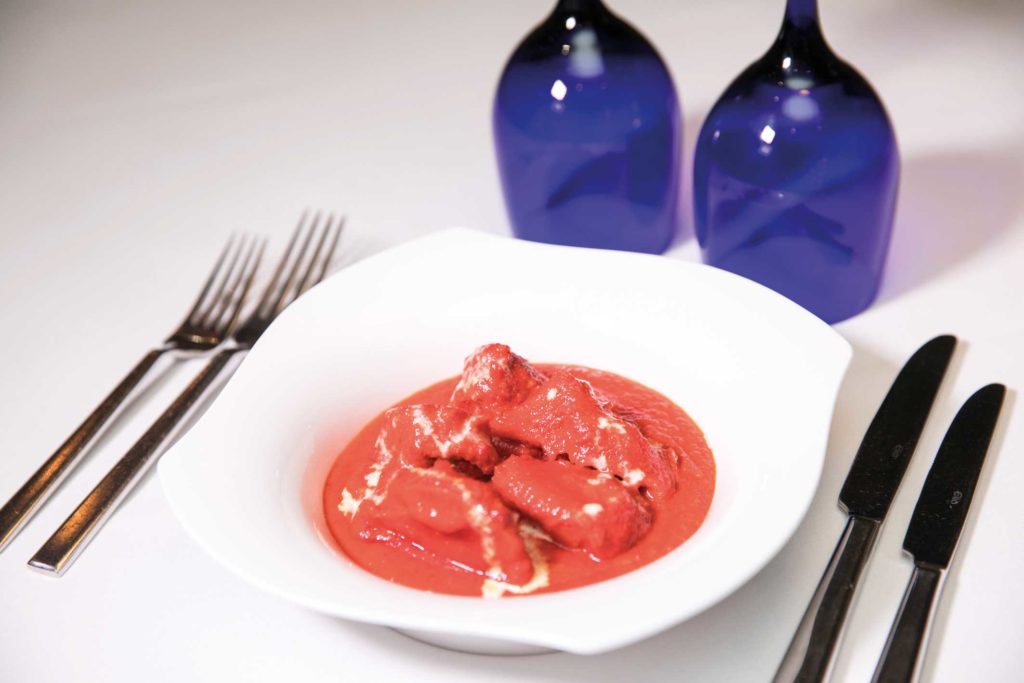
The star of the show was a Lamb Tangya featuring a series of spices which, at first sight, might have worked against each other but, as it turned out, the tender meat was accompanied perfectly by the garlic, ginger and mango.
That’s not to mention the onions, cumin and coconut which gave the thick sauce a really refreshing edge.
A close second was a plate of melt-in-the-mouth Butter Chicken – with off-the-bone chicken cooked in a mild creamy sauce.
Add to that a drizzle of sizzling lamb – and even hardy foodsters like myself and my companion were struggling to look at the dessert menu.
But we pressed on like true troopers and sampled some refreshing ice-cream because, as every bloated diner will tell you, ‘ice cream just slides down’!!
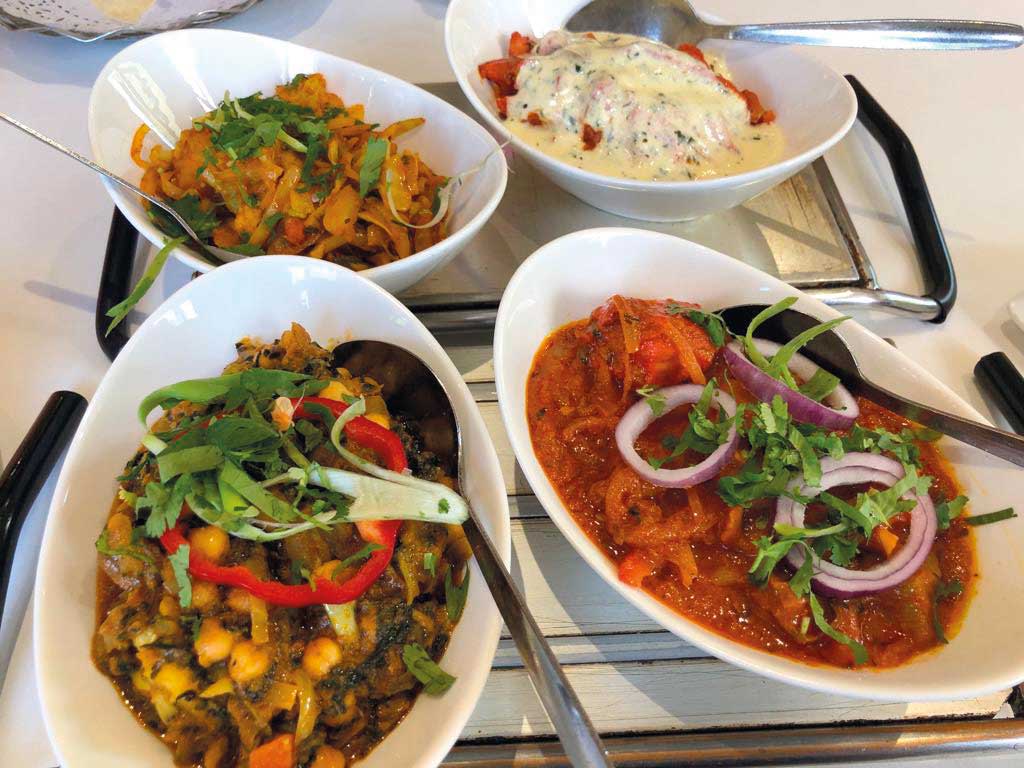
So did the Riverside Spice live up to the advanced billing?
Well before we started tucking in Abdul Hamid had advised us that a key strand of his philosophy was that – ‘you enjoy food first with your sight, then your smell and, only finally with your taste’.
The Riverside scored highly on all three counts.
First it offered the eyes well presented dishes in a beautiful setting – while the food also more than definitely passed the smell and taste tests.
It’s truly worth a visit to dine by the Riverside.
Riverside Spice is at Lower Holt Street,
Earls Colne, Colchester, Essex CO6 2PH
Tel: 01787 221728/221979
www.riversidespice.co.uk
Read more
A LITTLE LESS SALT
A pinch of salt can make a dish delicious; double the dose and it ruins the taste. More importantly, excessive salt can lead to several health problems. Though the human body needs this mineral for proper functioning, it should be consumed in moderation.
According to a World Health Organisation report, consumption of salt between 1,500 and 2,400 milligrams per day is recommended for adults. However, if one has or is at risk for high blood pressure, only up to1,500 milligrams is advised.

The Institute of Medicine’s Food and Nutrition Board suggests that both male and female teens between 14 and 18 years old should have only about 1,500 milligrams of sodium each day. Lifestyle modification should happen from an early age as there is no particular age for non-communicable diseases (NCDs) like hypertension.
Excess usage of salt can create several health hazards, hypertension being the most prominent. Others like abnormal heart development, osteoporosis, dehydration, swelling and digestive diseases have detrimental effects on the body.
Hypertension:
High blood pressure can trigger life threatening emergencies like strokes and heart attacks. Studies indicate that reducing sodium intake can lower blood pressure by 25 per cent. According to the Harvard School of Public Health, high intake of salt can cause 23 per cent increased incidence of stroke and 14 per cent rise in the incidence of heart disease.
Abnormal heart development:
A habit of eating salty food heightens the risk of non-blood pressure related heart diseases as well. The heart has to work much harder to provide proper circulation, when consumption of salt is more. This over a period of time results in an abnormally large heart with thinner heart valves. An enlarged heart is significantly weaker and can lead to symptoms like chest pains, breathlessness and chronic fatigue.
Osteoporosis:
Sodium inhibits the body’s absorption and utilization of calcium, leading to a loss of bone mass and increased porousness of bones. Elderly people, post-menopausal women and diabetics, who are already at high risk of osteoporosis, should be particularly careful about salt intake.
Dehydration and swelling: Excessive sodium in the blood draws water out of the cells and into the tissues. Feeling thirsty is a direct response after having salty food. Dehydrated cells signal the brain for water. Having fluid filled tissue makes one look bloated and swollen. These symptoms are especially severe in the lower parts of the body. Reducing salt intake is an effective way of preventing swollen feet, ankles and calves.
Digestive diseases: Sodium regulates the acid-base balance of blood and body fluids. Too much salt can yield acid reflux, cause heart burn and long-term damage to the upper digestive tract. Studies indicate that habitual intake of salty foods is a strong risk factor for duodenal and gastric ulcers and cancers.
There are ways to cut down salt consumption. One should opt for low-salt products and check ingredient labels to avoid products containing baking soda, sodium nitrate, sodium citrate and sodium benzoate. Salt free herbs and spices are a good substitute. At times, potassium is prescribed instead of sodium by doctors. Also, several brands these days highlight the presence of less sodium in their table salt.
Frozen, processed and fast-foods that we consume daily have high salt content, due which these should be used minimally. It is beneficial to choose fresh fruits and vegetables over processed ones and is advisable to rinse canned vegetables and fruits before consumption. A high intake of fruits and vegetables are protective dietary changes for a healthy life.
One should be cautious while picking products. A bottle of jam which maybe high in sugar content, also has salt in it in the form of preservatives which often go unnoticed. Consumption of plenty of water is a solution which is beneficial for the body and a natural cure for most NCDs.
Basil, garlic powder, onion powder and curry powder form excellent alternatives for salt which enhance food flavours.
Basil: Considered an important culinary herb, it is now commonly used fresh in cooked recipes. Alternatively, it can be chopped into homemade pasta sauces or tossed in with olive oil for healthy options as it has a sharp yet slightly sweet taste.
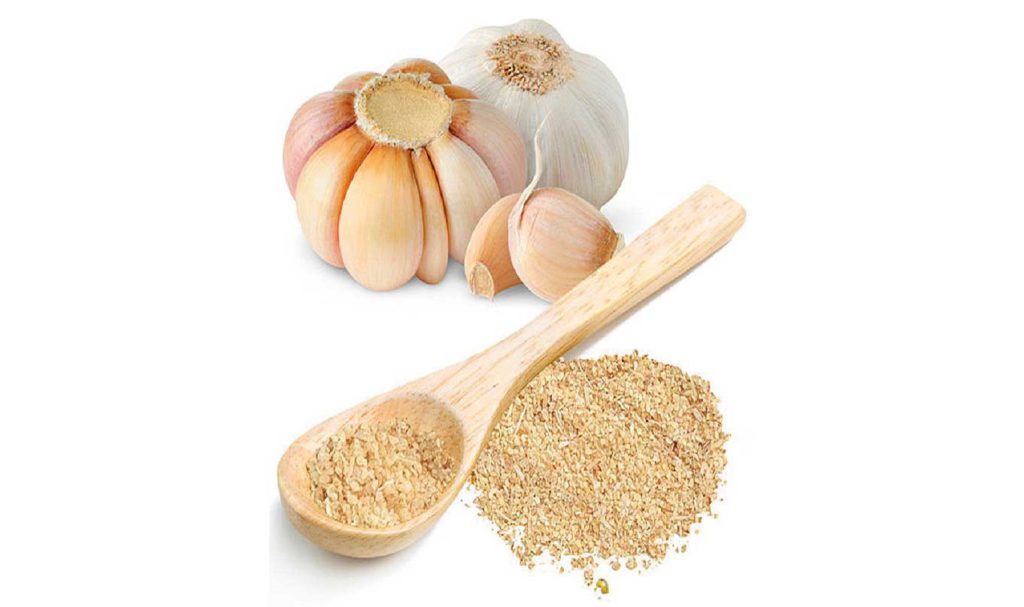
Garlic powder:
Enhances food flavours while offering other health benefits at the same time. When a bulb of garlic is roasted with a little bit of olive oil it goes from bitter in its raw form to a delightful sweetness. Using roasted garlic makes for a natural sodium source treat.
Onion powder:
A great salt alternative, but should be used sparingly due to its pungent flavour and strong taste.
Curry powder:
A rich flavour, which when sprinkled in dishes with vegetables and meat products, enhances the taste, reducing or eliminating salt usage.
One should become more mindful of salt intake in the diet, engage in regular physical activity and have a high intake of fruits and vegetables as these are key components of a healthy lifestyle.
Read more
Indian restaurants are aplenty in West Sussex’s seaside
Mahaan shows its might Indian restaurants are aplenty in West Sussex’s seaside town of Worthing, but the mighty Mahaan stands out.
The attractive blue name board, doors and window frames immediately catches the eye of any passer-by, who can be assured of ‘authentic Bangladeshi and Indian’ food. Mahaan, as the name suggests, is a great place for lunch and dinner, with family, friends or colleagues with a seating capacity for around 150. It has a bar and waiting area, where you can be seated comfortably or grab a drink before you place your order.
The claims of being ‘Worthing’s Premier Indian Restaurant’ is somewhat true as their history dates back to 1983, when Mahaan was launched and is touted as one of the oldest restaurants in town. The menu too stands out with some exceptional dishes such as Murgh Bhazzan, Lamb Mashriki and Basha Prawns and their own version of Murgh Sylhety, Naga Chicken, Bangladesh Fish Curry and Fish Shatkora.
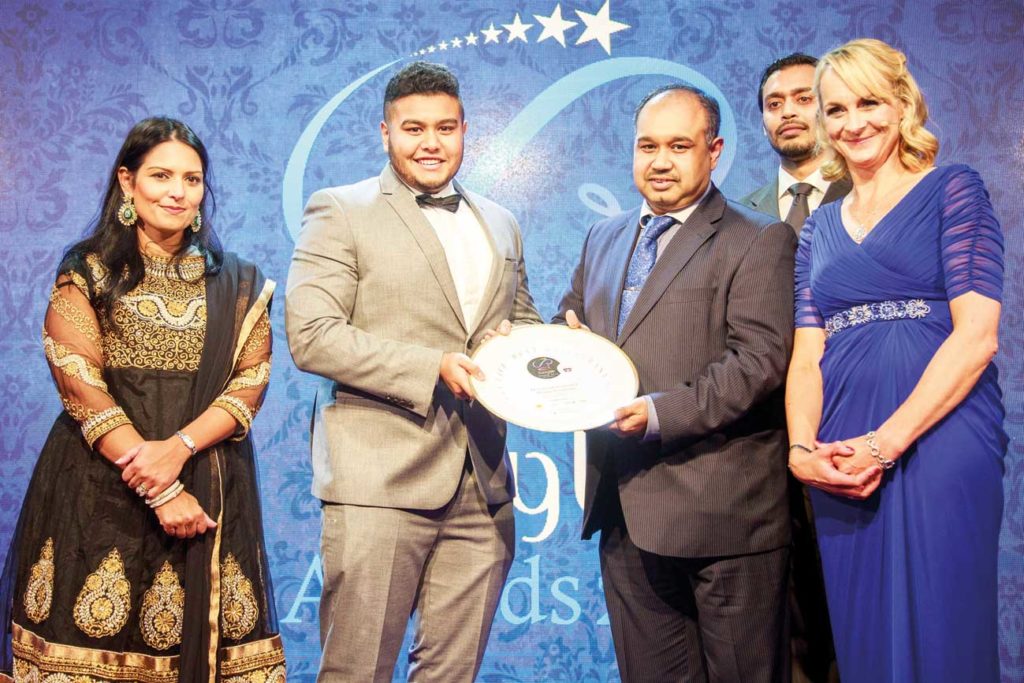
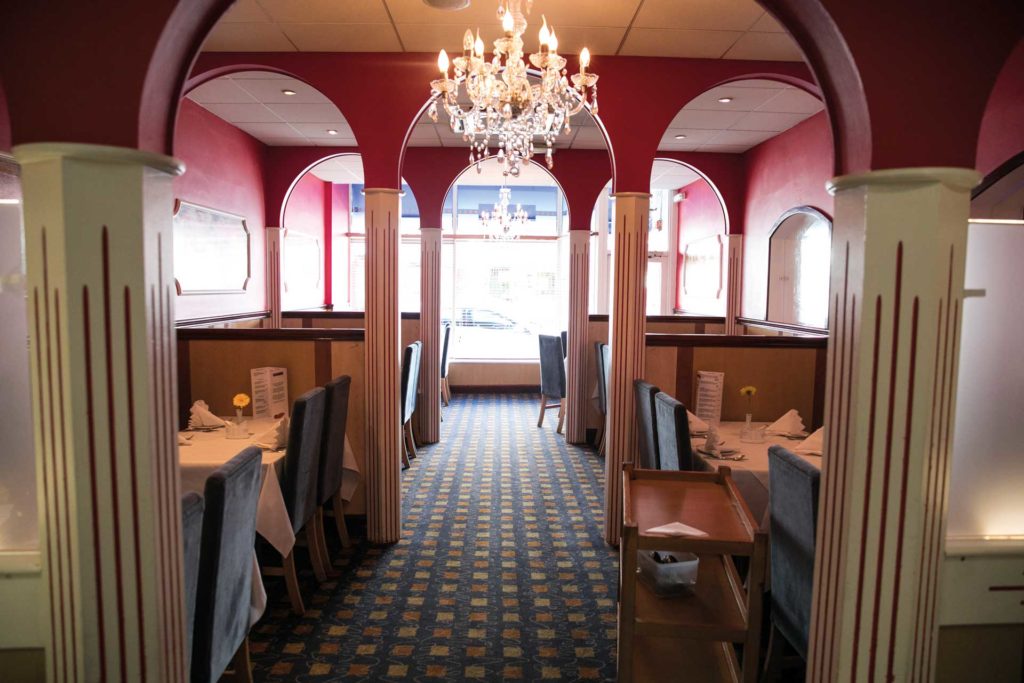
In a candid chat, owner Askor Ali reveals how the restaurant got that name. “Amitabh Bachchan-starer Bollywood movie Mahaan had released and it did very well at the box office in 1983. So that’s one of the reasons why the restaurant’s name got considered. Moreover, mahaan means great and it appealed to all the partners back then,” Ali recollects.
The Montague Street restaurant certainly lives up to its name, having won the hearts of many customers with its spectacular service and quality dishes. Many a times, customers already know what they want even before they settle in as they visit frequently and are aware of the choices and dishes. Customers can expect a friendly welcome and quality food, with an extensive menu to choose from, both for eating in and takeaway. “We have been serving in Worthing for more than 35 years now and we value every customer and try our best to deliver quality food with the best service,” he confirms.
The Mahaan started with the conversion of a single shop into a small restaurant and bar. It was then further extended into the next shop on the east side and followed by the third which now adds up to the space of three shops. The business does not mind further expansion at the same property, should the opportunity arise.
On acquiring and launching more restaurants, Askor says, “At the moment, I am just focusing on this restaurant. We do have other restaurants in the family – one in Bognur Regis, Swanage in Dorset. My focus is on our ratings – we have constantly maintained our 5-star rating and follow all health and safety regulations. Our menu has special page related to allergens and precautions.”
Though business is brisk during summer months, Askor’s restaurant is more popular among locals. “We do have a fair number of local customers, who visit frequently. Many people travel during summers, so that almost balances out locals and tourists visiting the restaurant,” he analyses.
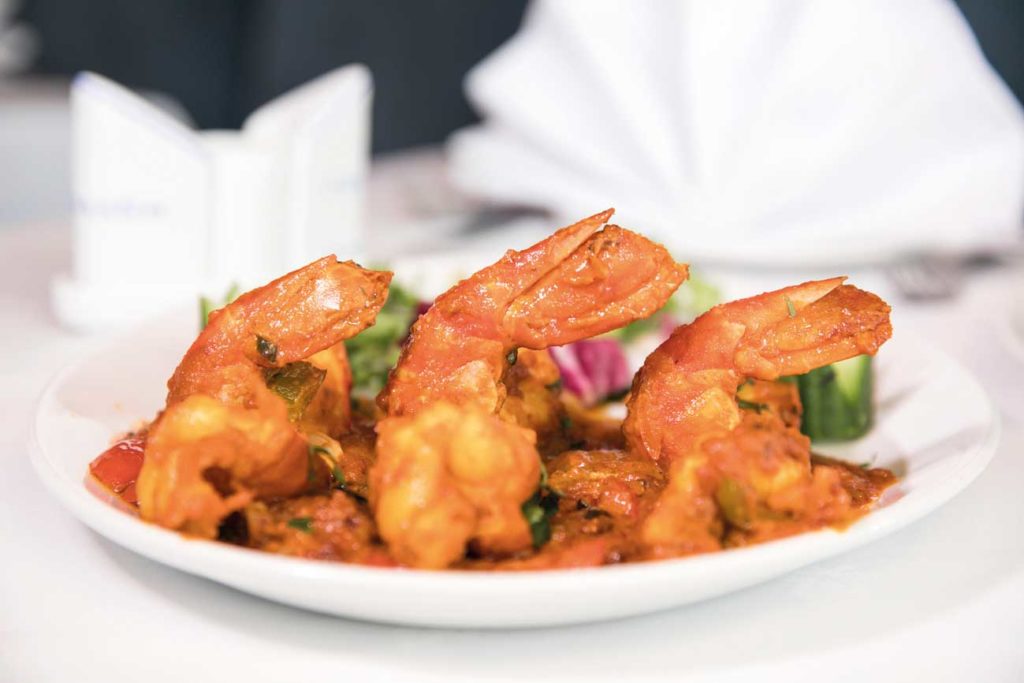
A major problem most restaurants are facing these days is shortage of staff. However, Ali feels he’s been lucky on this front. “I have my close family and relatives helping me in my business. My sons – one is at university and another is pursuing a career in accountancy – work with me over the weekends as that’s the time when the restaurant is most busy,” adds Ali, stating he is supported by his nephew Mujibur Rahman and niece’s husband Shalim Ahmed in his Worthing business.
“There has been no pressure from my side on them to pursue restaurant business ever – I’ll always support them in whatever profession they choose – doctor, engineer or restaurateur. As long as they are interested in what they are doing and good at it,” he says.
Recollecting his early days in UK, Askor says his experience with different restaurants helped me master the trick of the trade. “I came to England with my mother when I was 11 years old as my father was already living and working here in a restaurant in Bognor Regis. We lived there for a few years until 2005, until I took charge of Mahaan in this town,” adds Ali, who managed restaurants in Swanage, Shoreham and Brighton before.
“I am very familiar with all these areas and I like living in this part of England,” says Ali, which explains his affinity towards seaside towns. The sea is at a stone’s throw, and after a pleasant stroll, a perfect meal is what one looks forward to.
Competition from neighbouring restaurants is no threat. “Worthing has plenty of Indian restaurants, but all aren’t doing well. In fact, many have already closed down. Every customer who dines out looks for good quality and excellent service. If you are confident about these two factors, your business will definitely thrive,” he states.
“Another important point I like to make – you have to know your trade in and out. I can work as a chef, a waiter, a kitchen porter or a delivery driver. That is the key to success in this industry,” he adds.
What role does he consider best? “If I had to choose from the multiple roles, I’d mainly be in the kitchen, as a head chef. My cousin is the main chef here but when they get really busy, I go in – give him a hand, he feels more comfortable as well and less stressed,” he says with confidence. Askor enjoys other cuisines such as Turkish, Persian and Mediterranean. When not in his restaurant, he likes watching TV and sometimes gardening.
The restaurant has bagged a number of awards and recognition and featured in local newspapers and magazines. “It is very motivating when your efforts are recognised. It’s good for the restaurants reputation,” Ali says, adding, “Apart from Curry Life Awards, we have won British Curry Awards, Asian Curry Awards, and have regularly participated in cooking competitions and workshops.”
Mahaan is open every day, 12pm to 2pm and 5.30pm to 11.30pm, extending to midnight on Friday and Saturday.
Mahaan Restaurant,
177-181 Montague Street
Worthing, BN11 3DA
Contact No. 01903 205449 / 01903 207299
Email: info@mahaan.co.uk
Read more


